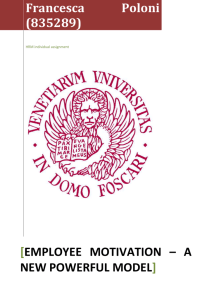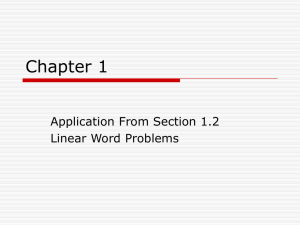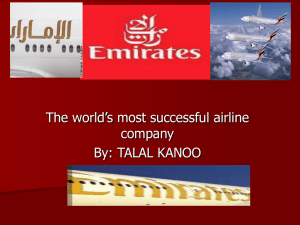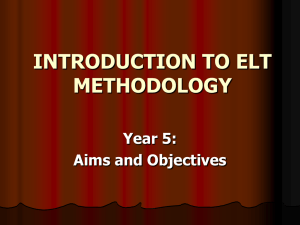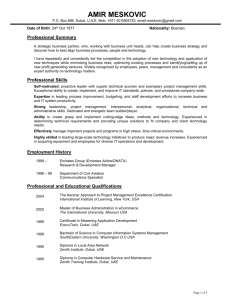“EMPLOYEE MOTIVATION, a powerful new model” INTRODUCTION
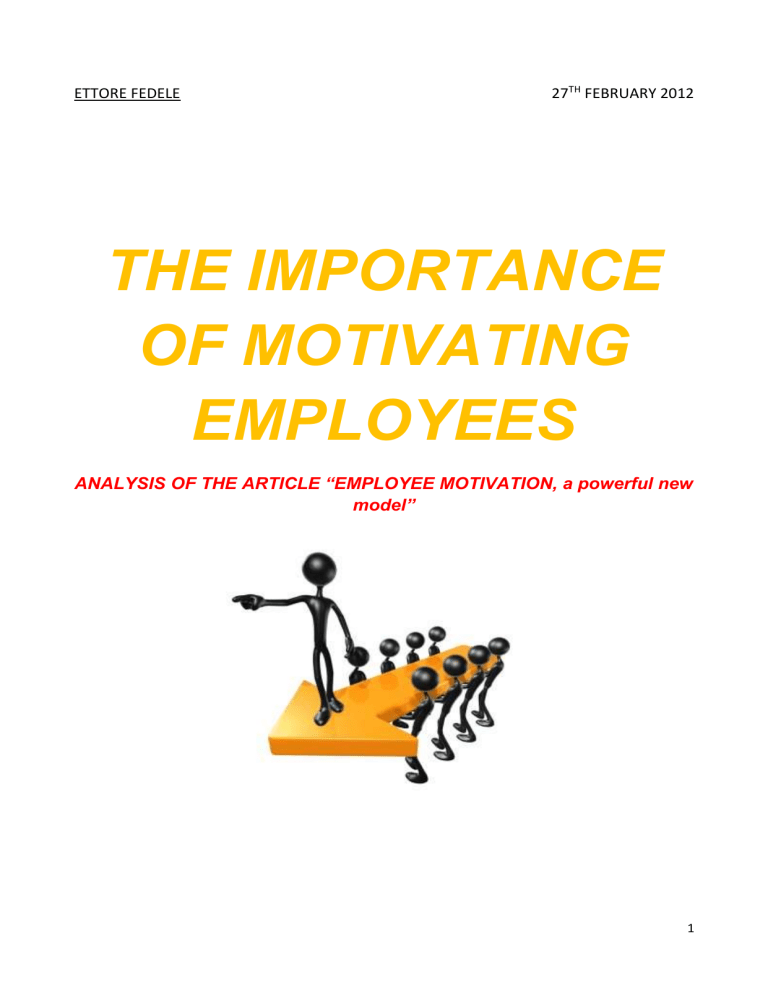
ETTORE FEDELE 27 TH FEBRUARY 2012
THE IMPORTANCE
OF MOTIVATING
EMPLOYEES
ANALYSIS OF THE ARTICLE “EMPLOYEE MOTIVATION, a powerful new model”
1
INTRODUCTION
What the authors aim to do by writing this article is to figure out the main important and newest aspects of employee motivation. The core theory is based on the analysis of the so called four “drives”, which are actually the needs deriving from the common evolutionary heritage:
The drive to ACQUIRE
The drive to BOND
The drive to COMPREHEND
The drive to DEFEND
Nitin Nohria (dean of the Harvard Business School from July 2010), Boris Groysberg
(professor of Business Administration in the Organizational Behavior unit at Harvard
Business School) and Linda-Aling Lee (Vice President and Senior Analyst at MSCI ESG
Research) are the tree authors of the article which is comprehensive of a brief introduction to the core topic, the analysis of the four drives (acquire, bond, comprehend and defend), and a in depth description of the tools needed to fulfill these four human-employee needs so that to improve their motivation, i.e. increase in organizational performance. The final part regards the importance of the direct manager as the person who can, even though acting constrained by various limits, facilitate and allow the process of meeting all the four.
The article is a presentation of a new model of motivating people acting within an organization.
The following work is aimed at analyzing by a HR perspective the contents of the article and provide also some major information about the importance of motivating people within an organization, using graphs and examples. It is made up by the main body, which consists in the analysis of the core theory, and conclusions. References can be found at the bottom of the text.
1 ST STEP - ANALYSIS OF THE CORE THEORY
2
For motivation to be improved, in order to increase the organizational performances, the four drives must be respected. The core theory is that nowadays employee motivation has come to be a very important issue for the success of an organization. Ensuring the four drives and shaping the organizational structure, so that to deal with and facilitate the motivation process, is not only important but also necessary. The drives (that are the drive to acquire (obtain scarce goods, including intangibles such as social status), bond (form connections with individuals and groups), comprehend (satisfy our curiosity and master the world around us), and defend (protect against external threats and promote)), when respected, lead to an improve in motivation; which can be measured using four workplace indicators: engagement (the energy, effort, and initiative employees bring to their job), satisfaction (extent to which they feel that the company meets their expectations at work), commitment (extent to which employees engage in corporate citizenship) and intention to quit (the best proxy for employee turnover). A very important point of the overall question is that the four drives are not characterized by a hierarchical order for they count for same weight in improving motivation; improving just one of them will not lead to an environmental development within the organization.
There are several different examples of organizations that are in some way following this kind of approach; Emirates together with Etihad (the UAE national airline), for instance, is trying to give a definite and clear imagine of the company.
Watching the cabin-crew recruitment video on Emirates youtube.com channel, you can see how much importance and emphasis the company puts in underling such aspects as becoming someone important by working for one of the leading airlines recognized worldwide (drive to acquire intangibles); being part not only of a work team but of a large family (flight attendants for example can choose to share their flat, provided by the company with all the facilities needed to ensure a wealthy and happy life such as gyms, swimming-pools and spas, with their colleagues in a friendly environment; i.e. the drive to bond); becoming conscious of the mechanism behind this kind of job and life (in the video you can hear that working as a member of the cabin crew has a glamour side, you are allowed to visit different countries, experience different realities, be guested in five star hotels, and a not so glamour side such as too wake up early in the morning, deal with jetlag, having no fixed place to live in; also the training course provides you with information even about the plane and the engine; i.e. the drive to comprehend); and last, having the possibility to develop your own career (if you
Emirates Airbus a380, the world’s largest passenger airliner
3
are regarded as being a good worker and having the right willingness you are supposed to acquire new responsibilities and having an increase in the wage as well; good performers are then supposed to gain benefits despite of those who work in a bad way, justice is promoted, that is the drive of defend). These and others are the points on which Emirates concentrates its efforts while recruiting new people and motivating its current employees.
Evidence proves that this kind of approach is working and giving striking results; Emirates, that was born in Dubai only in 1985, is now the most prestigious airline company in the world and yet it is developing day by day (indeed it has the youngest fleet) and hundreds of people from all over the world apply every year for a career position.
Even though in the report great importance is given to the necessity of acquiring all the four drives simultaneously, past experiences underlined that the way to fulfill them is better reached through different organizational levers. The studies ran by the three authors have led to a description of the organizational levers as important tools for the motivation development. The reward system, applied also by Emirates for the advancement, easily satisfies the drive to acquire. The scholars focused their efforts on analyzing such organizations as the Royal Bank of Scotland and Sonoco (manufacturer of packing for industrial and consumer goods) by the above perspective.
The most effective way of fulfilling the drive of bond is to create a culture that promotes collaboration, network and friendship. From the economic point of view organizational culture is “a pattern of shared basic assumptions invented, discovered, or developed by a given group as it learns to cope with its problems of external adaptation and internal integration, that have worked well enough to be considered valid and therefore, to be taught to new members as the correct way to perceive, think and feel in relation to those problems” (Schein). It has also been defined as "the specific collection of values and norms that are shared by people and groups in an organization and that control the way they interact with each other and with stakeholders outside the organization. Friendship and collaboration could also be improved by training; Benetton Group for example provides to its employees on average 3 day trainings, locally at Asolo Golf Club in the northern Italy, where people are required to attend some exercises provided by actors and psychologists, working together, so that to increase the trust in one-another. Events, like dinners and even disco parties, are sometimes organized by the clothing retailer, so that to facilitate and promote the chances of building new friendship relations among employees, i.e. socialization (the process of entering the culture of a specific organization).
4
Job design on the other hand is important for the drive to comprehend. Different tools in job design could be used in order to provide motivation; make employees feel covering important and meaningful roles, fostering the sense of contribution to the organization is one of these. Others are for example job enlargement and rotation (respectively expand a job’s duties and rotates the workers among different tasks without disrupting the flow of work, in order to reduce fatigue and boredom, keeping in mind that the only limitations the skills variances) and job
The Tramp working on the giant machine in the film's most famous scene enrichment (the process of putting specialized tasks back together so that one person is responsible for producing a whole product or an entire service). “Team based design” is another job design approach that is achieving great importance (it is focused on giving a team a whole and meaningful piece of work). In contrast to Taylor-Weber theory, on the importance of specialization and bureaucratic organizational structure to maximize a firm’s performances, it has been seen that allowing workers to focus on entire and meaningful process, rather than on just a part of a whole, leads to better results. This is due to the fact that specialization leads to demotivation because of the routine. This topic has been firstly denounced by Charlie Chaplin’s film
“Modern Times”. In the most famous and emblematic scene, Chaplin suffers a mental breakdown (brought about by the repetitiveness of his job’s duties) that causes him to run amok, throwing the factory into chaos.
Another important aspect of job design is the so called “goal setting”; setting clear, specific and difficult yet achievable goals, sounds like a challenge for employees who are motivated to do better.
MOTIVATION
This graph shows how motivation varies when goals are easy, difficult and impossible
EASY DIFFICULT IMPOSSIBLE
Lastly, transparent processes for performance management and employee resource allocation help to meet people’s drive to defend. Performance management is based on the “performance appraisal system”, which includes the identification (determining what areas of the work the manager should be examining), measurement (entails making
5
managerial judgments of how “good” or “bad” employee performance was) and
management (managers must provide workers with feedback and coach them to higher levels of performance). This is an important tool held by managers; indeed, exploring and analyzing the causes of performance problems together with employees and then finding right solutions (through performance-focused communication), are actions aimed at improving employees’ performance. MBO (process of defining objectives within an organization so that management and employees agree to the objectives and understand what they need to do in the organization) is a good way of achieve better performance.
As you can read in the article, some organizations, beyond training and scholarships, offer benefits, such as on-site child care, that enhance work/life balance. Google, for example, allows its employees to bring also their pets at the workplace (for these and a lot of other reasons it has been voted as the best company to work for).
The following paradigmatic graph, reported in the article, lets you to understand the big strides in employee motivation brought about by the fulfilling of all the four employees drives:
“The increase in motivation leads to major competitive advantage for a company in terms of employee satisfaction, engagement, commitment, and reluctance to quit”
The final step of the analysis is focused on the importance of the direct managers. Even though employees well know that organizations are affected by many environmental constraints, all they expect from their supervisors is the willingness and ability to do the best possible to address their four drives.
In such a context, HR managers play an important role in balancing workers’ aspirations with organizational needs. HR manager is a professional figure resulted from a process started in the early 20 th century, called “human resources movement” (studies on the
6
behavior of people in workplace groups). HR managers have to deal with critical situations; in particular they are important, for example, in recruiting new people and strategic planning. Because they are the ones who hold the information about employee, they work next to other managers so that to design the work in the best way possible in order to maximize organizational performances while fulfilling (or at least trying to fulfill) all the four workers’ needs.
CONCLUSIONS
The message we can extrapolate from the article is that the challenge for today’s managers is to find the right way to motivate workers in order to reach better results in terms of organizational performance. Indeed, studying the HRM theory, we get to know that motivation, together with individual competences and resources, allows people to perform better, for it contributes to influence their behavior. The behavior is made up by three main elements that are:
Direction
Level of effort
Level of persistence
All together these elements lead to job performance.
As far as motivation (set of forces coming from within a person) is concerned, it could be either intrinsic or extrinsic:
Intrinsic motivation: a behavior performed for its own sake (this is a very important aspect for you do not perform well because you are scared of being punished or you want to be rewarded, but because you want to do so, you want to put your best in everything you do)
Extrinsic motivation: a behavior performed to acquire material or social reward or to avoid punishment
As we can read in the article, motivated employees are encouraged to work better leading to major results and then to competitive advantage; therefore motivating people is one of the most crucial aspects that managers should take into account while designing the structure of organizations. Workers are no longer tools, they are regarded as people, as members of the organizations; stakeholder is the key word. They are necessary for the success of the firm, that is why they should feel fine in their workplace, and model proposed by the three scholars is aimed at providing managers with the tools needed to achieve this goal.
7
The very last point on which it is worth to spend some words is to underline the fact that wage is not taken into account as a motivational factor for, according to Herzberg, it is a
“hygiene factor”. Hygiene factors, also called maintenance factors, are external to the job, they belong to the work environment; this does not mean that this kind of factor is less important, indeed its absence leads to active dissatisfaction and demotivation. Hygiene factors are the following:
Company policies
Working conditions
Job security
Salary
Employees benefits
Relationships with supervisors and managers
Relationships with coworkers
Relationships with subordinates
8
REFERENCES
“Employee motivation, a powerful new model” (N. Nohria, B. Groysberg and L. Lee)
Emirates.com
Benetton.com
“Managing human resources” (global edition) PEARSON
Contents of class lectures
9
